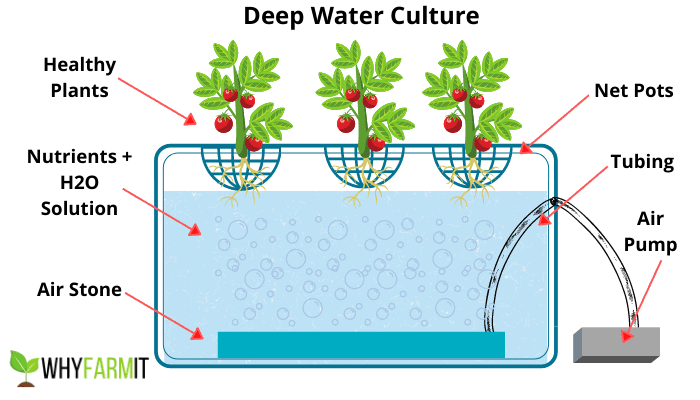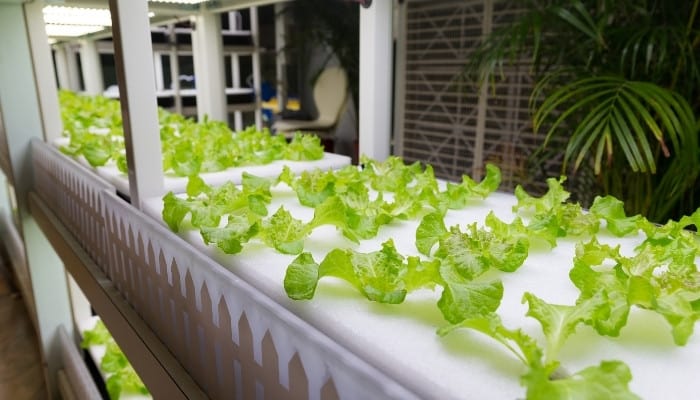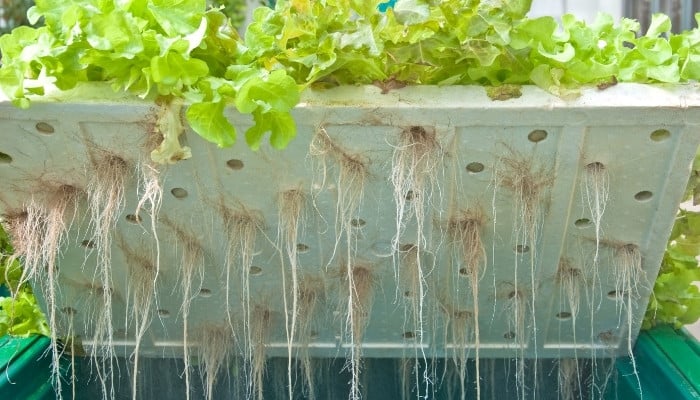Deep Water Culture, often abbreviated as DWC, represents one of the simplest types of hydroponics.
For beginners, the DWC method is a sure-fire way to get started with hydroponics. With DWC, you are up and going with minimal expenses and the smallest learning curve possible.
How does deep water culture work? DWC is a hydroponic technique, or method, that revolves around suspending plants above a reservoir. Plants are anchored to the system in netted pots, with or without an additional growing medium. Suspended above the reservoir, the roots dangle down and absorb water, nutrients, and oxygen as needed.
In this guide, we discuss everything you need to know about DWC hydroponics.
Read on to discover the simplistic beauty of deep water culture and to find out if it’s the right method for you.
Deep Water Culture: The Basics
The DWC method is one of the most successful hydroponic techniques around.
Furthermore, it’s a great way to get into hydroponics or to learn about hydroponic cultivation in general.
Below, we take a closer look at all of the deep water culture basics you need to know before getting started.
How Deep Water Culture Works
DWC works in a fairly straightforward manner.
A reservoir is filled with water, nutrients, and an air supply. A lid is attached to the top of the reservoir, with one or more grow sites for netted pots.
Plants are positioned into the netted pots, and their roots soak in the water held by the reservoir.
Liquid nutrients are introduced to the system manually, and adjustments are made to pH and EC (electrical conductivity) levels as needed as well.
Air is produced by a submerged bubbler, air stone, or similar component.
The plants, firmly anchored in their pots, stretch their roots down into the water and absorb everything they need to live and thrive, minus light.
Light is provided by grow lights indoors or by the sun outside.
In addition, ventilation is often included outside of the reservoir to help cool and stimulate the plants.
As there are several versions of DWC hydroponics, the description above is a generalization. In the next section, we discuss the main varieties of DWC systems.

Deep Water Culture Diagram
Types of Deep Water Culture Systems
Several creative forms of DWC systems have evolved over the years. A few of the most commonly known DWC methods include:
Traditional DWC
The traditional DWC system, or classic DWC setup, consists of a tank, lid, net pots, air pump, and air stone. Traditional DWC systems work both indoors and outdoors.
Classic DWCs are among the most basic forms of hydroponics and take little time to master. The section above explains how the traditional DWC systems work in detail.
RDWC
The recirculating deep water culture, or RDWC for short, is a beefed-up version of the traditional DWC method.
The system works somewhat like a hybrid between a classic DWC system and the flood-and-drain hydroponic technique.
It’s not considered an ebb-and-flow system, however, because the water is never drained completely.
Instead, water and nutrients are recirculated from each reservoir to the next.
Eventually, the water returns to the main reservoir and begins flowing through the entire system again.
RDWC systems typically consist of several bucket-like reservoirs designed for growing a single plant. Each container is connected to the next one in the series via a hose.
Because the traditional DWC has its own downsides and cannot scale big, the recirculating deep water culture was created.
This type of DWC requires a bit more time to set up, extra air stones, and of course, a bit more cash as well.
Kratky Method
A more primitive take on the traditional DWC technique is the Kratky method.
This method is identical to a classic DWC system minus one aspect; the Kratky method doesn’t utilize an air pump.
To properly aerate root systems using the Kratky system, there must be a large enough space between the root system and the top of the water.
This gap between plant and reservoir allows the plant to breathe in air in a fashion similar to how soil-grown plants do.
One of the biggest advantages of the Kratky method is that no electricity is required. However, it can be a bit tricky to get the hang of.
If you’re a fan of organic gardening, a minimalist, or are simply looking for the most affordable form of hydroponics to get involved with, this could be the method for you.
Bubbleponics
The DWC method known as bubbleponics is another interesting and successful hydroponic technique.
It is quite similar to the standard DWV setup, except that it involves the addition of a water pump submerged within the reservoir.
The water pump sends water up and into the tops of your netted pots, soaking the seedlings and providing them with water and nutrients.
This technique helps to stimulate growth and speeds up root development.
All things considered, bubbleponics is more of a technique than a complete growing method because it is often not used beyond the germination phase of growing crops.
That said, if used long-term, it is considered a top-feeding DWC system.
Hybrid DWC
Aside from the main DWC methods listed above, there are all sorts of hybrid systems that ingenius gardeners have designed.
These hybrid DWC systems are lesser-known, as most of them are one of a kind and aren’t often duplicated.
A quick Google or YouTube search may yield several results for homemade and DIY hybrid DWC systems.
Deep Water Culture Hydroponics Pros & Cons
How To Set Up a Simple Deep Water Culture System
Setting up a basic deep water culture system is genuinely an easy process as far as setting up hydroponic systems is concerned:
Components: What You’ll Need To Get Started
To get started, collect these supplies (or purchase a kit):
- Large container with a lid (a 5-gallon bucket or large tote works just fine)
- Air pump (a fish tank pump will do)
- Air stone (again, one for fish tanks is good)
- Net pots (1 if using a bucket, up to 8 if using a tote)
- Liquid nutrients
- Hydroponic pH kit (including test strips or meter)
- Optional: growing medium (pebbles, gravel, rockwool, or clay pellets)
- Optional: submersible water pump (for bubbleponics technique to speed up germination)
Assembly
The assembly phase doesn’t take long:
- Trace the bottom of your net pots on the lid of your container with a marker, cut them out with a sharp instrument.
- Insert the net pots into the lid, and set the lid to the side.
- Fill the container with water, effectively transforming it into a reservoir.
- Add nutrients, allow the water temperature to adjust, and test/adjust pH levels.
- Connect the air stone to the air pump, and place it inside the reservoir.
- Place the lid on top of the reservoir, insert a growing medium if you are using one, and anchor your plants inside the pots.
Now you’re ready to plug in the air pump and start growing! Keep in mind that lighting is another installation process of its own.
Maintaining a Deep Water Culture System
Taking care of a DWC system is about as easy as it gets. Unlike other hydroponic setups, DWC systems are normally small and simplistic.
Aside from monitoring water temperatures and adjusting pH and EC levels as needed, there are a few basic tasks involved with maintaining a DWC system.
Most importantly, you need to change out the water every two weeks and clean the reservoir.
Avoid using any chemicals while scrubbing and cleaning the inside of the reservoir as even trace amounts of harsh cleaners may kill your plants.
Instead, opt for a hydroponic-friendly cleaning solution.
In addition, cleaning the air stone or filter is also necessary. Other than that, just remember to keep water and nutrient levels topped off regularly.
Deep Water Culture Average Costs
Depending on whether you are the DIY type or prefer to purchase a professionally designed system, setup costs for DWC systems range from $100 to over $1,000.
That said, large pre-made systems may cost upwards of $5,000 or more.
Upkeep also costs between $50 and $150 per month counting electricity bills, cleaning supplies, replacement parts, and nutrients.
Depending on the size of your system though, DWC upkeep is by far the cheapest of all hydroponic systems.
What Can You Grow in DWC?

There are a plethora of plants that you can grow in DWC (even though the list is much shorter than with more advanced hydroponic systems):
- Lettuce
- Microgreens
- Spinach
- Kale
- Cabbage
- Onions
- Radishes
- Turnips
- Basil
- Parsley
- Mint
- Various peppers
- Cherry tomatoes
- Strawberries
- Many small houseplants
The above list is far from exhaustive. Depending on the size and type of DWC, numerous additional plants are able to be grown with DWC.
Is Deep Water Culture Good for Beginners?
Deep water culture systems are excellent for beginners. They are quick and easy to set up and require a hands-on approach that leads to a deeper understanding of hydroponics.
DWC is also cheaper than most types of hydroponics.
So, it’s perfect for those who are on the fence about hydroponics and want to get hands-on experience before investing in an advanced system.
Furthermore, DWC systems are often used in schools for learning purposes.
How Much Water Do You Need for Deep Water Culture?
The only rule of thumb for how much water you need for deep water culture is that the water level should measure between 3/4 and 1 inch from the bottom of the net pots.
So, more or less, it depends on the size of your reservoir.
Water levels in deep water culture setups need to keep plant roots submerged.
Therefore, if you’re using a 5-gallon reservoir, expect to fill it with as much as 4.5 gallons or more.
Likewise, in a 20-gallon reservoir, you may need as much as 19 gallons or more.
What Nutrients Do I Need for DWC?
The list of nutrients needed for DWC is as follows:
- Nitrogen
- Phosphorus
- Potassium
- Magnesium
- Calcium
- Sulfur
- Iron
- Boron
- Chloride
- Copper
- Manganese
- Molybdenum
- Zinc
What’s the Best Growing Medium for Deep Water Culture?
Growing mediums, aside from the netted pots themselves, aren’t absolutely necessary for DWC.
That said, a few of the best growing mediums commonly used for DWC include:
- Clay pellets
- Perlite
- Lava rocks
- Rockwool
Does DWC Increase Yield?
All forms of hydroponics, including DWC, increase crop yields. In comparison to soil-grown plants, DWC systems may increase yields by as much as 30% or more.
DWC also speeds up plant growth by as much as 50 to 60% or more than traditional methods.
Do You Need Grow Lights for DWC?
You only need grow lights for DWC if your setup is of the indoor type. Outdoors the sun is more than ample light.
Indoor DWC setups work best with high-pressure sodium lights, compact fluorescent lights, LED, or metal halide lights.
How Often Should I Change the Hydroponic Water?
Hydroponic on average requires changing every 10 to 15 days.
If your water becomes tainted by chemicals, root rot, or develops an unhealthy pH or EC level, it should be changed immediately.
What Temperature Should the Nutrient Solution Be?
Nutrient solutions for DWC systems should remain between 65℉ to 80℉.
Anything higher or lower than this suggested range may cause your plants to struggle to breathe. High temperatures may also lead to root rot and dead plants.
How Do I Control the Water Temperature on My DWC?
There are a few effective ways to control the water temperature of DWC:
- Keep the water levels topped off.
- Pump enormous amounts of air into the water.
- Keep the reservoir protected from excess light.
- Add plant-friendly additives for cooling water.
- Install a cooling coil.
- Bury the reservoir in the ground.
How Much of the Roots Should Remain Above the Water in DWC?
Roots should remain approximately 1 inch to 1.5 inches above the top of the water in deep water culture systems.
They need just enough room to easily take in extra air from the gap between the plant and water. This small space also helps combat root rot.
Can Deep Water Culture Be Used for Aquaponics?
DWC and aquaponics work very well together.
In fact, this form of hydroponics and aquaponics combined has been in use for centuries, as far back as the Aztecs or even further in ancient Asian cultures.
The simplest form of DWC aquaponics is identical to classic DWC setups, except you swap out the reservoir for a fish tank with live fish.
Is RDWC Better Than DWC?
There is no clear winner between RDWC and DWC. Depending on your intentions and purposes, either system could be better.
For example, DWC is better than RDWC for small indoor setups. On the other hand, RDWC is far superior for growing multiple large plants outside.
Is DWC Drain to Waste?
Most DWC are self-contained or recirculating systems. That means DWC is not normally drain to waste.
However, if you prefer, it is possible to create a DWC system that incorporates the drain-to-waste technique.
What Can You Do With Hydroponic Runoff?
There are several creative ways to use hydroponic runoff. A few of the most common things to do with it are:
- Using it to water plants outside of your hydroponic system.
- Mixing it with fresh water and reusing it in your hydroponic system.
- Simply pouring it down a drain in the bathroom or kitchen.
Common Problems With DWC (and Solutions)
Final Thoughts About DWC Hydroponics
Learning about deep water culture is often the first step to becoming a full-fledged hydroponic gardener.
DWC is inexpensive, easy to learn, and produces incredible results compared to traditional gardening techniques.
If you’re interested in growing your own food or simply want to get some hands-on experience with hydroponics, DWC could be the system for you to invest in.
And if you enjoyed learning about this grow system, check out my article on bubble buckets.

